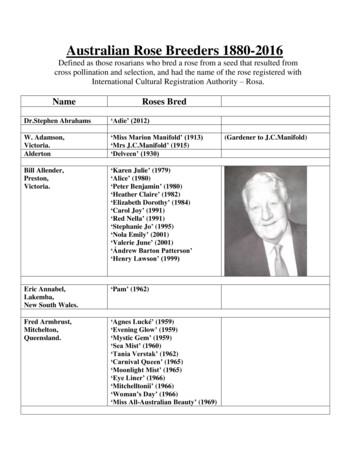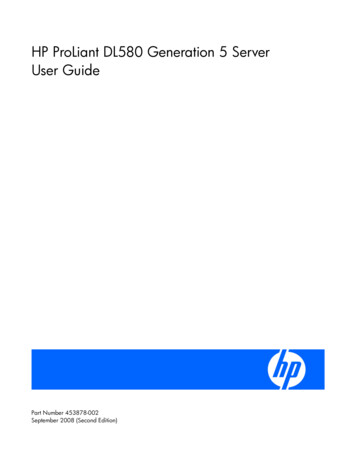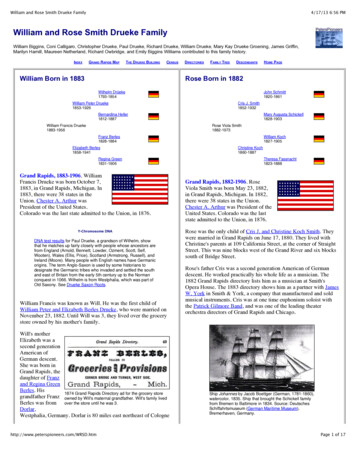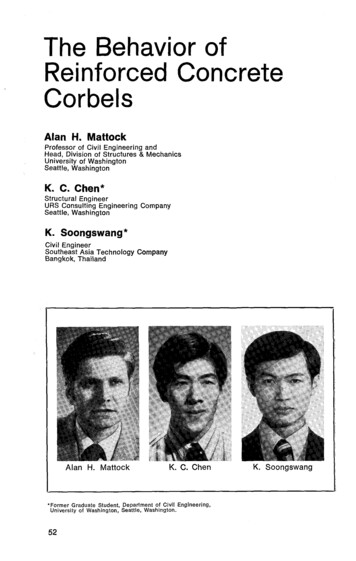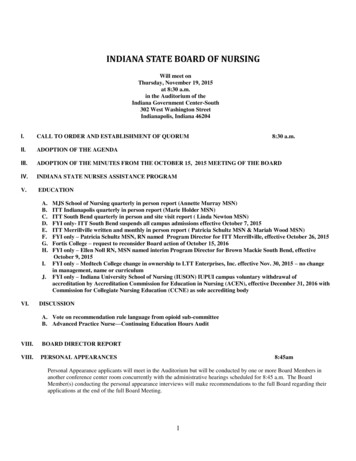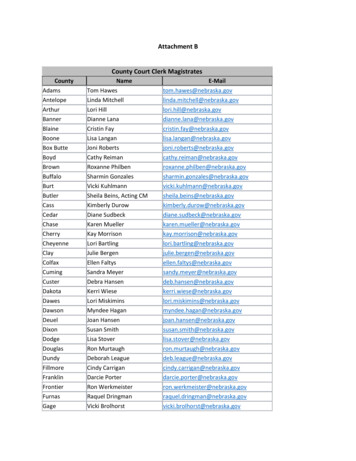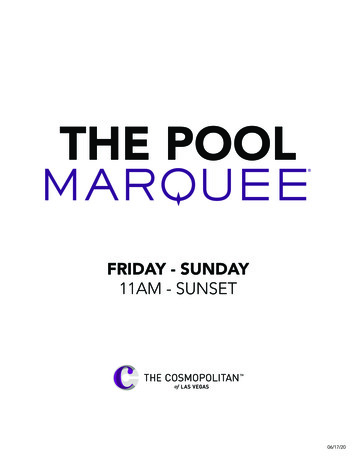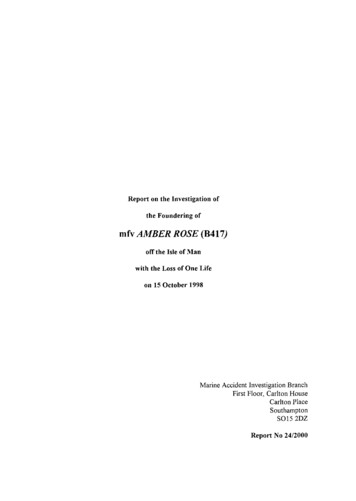
Transcription
Report on the Investigation ofthe Foundering ofmfv AMBER ROSE (B417)off the Isle of Manwith the Loss of One Lifeon 15 October 1998Marine Accident Investigation BranchFirst Floor, Carlton HouseCarlton PlaceSouthamptonSO15 2DZReport No 24/2000
Extract fromThe Merchant Shipping(Accident Reporting and Investigation)Regulations 1999The fundamental purpose of investigating an accident under these regulations is to determineits circumstances and the causes with the aim of improving the safety of life at sea and theavoidance of accidents in the future. It is not the purpose to apportion liability, nor, except sofar as it is necessary to achieve the fundamental purpose, to apportion blame.
CONTENTSPageGLOSSARY OF ABBREVIATIONS AND TERMSYNOPSIS1VESSEL AND ACCIDENT PARTICULARS2SECTION 151.16SECTION 22.12.22.32.42.52.62.72.82.92.102.112.122.132.14- FACTUAL INFORMATION5Description of VesselBilge Pumping ArrangementsBackground to the VoyageThe CrewEnvironmental ConditionsNarrative of EventsEyewitness to the AccidentRSW Tanks (Extensions)Vessel’s StabilityRSW Tanks (Condition)Vessel’s Refit (Buckie Shipyard)Maritime and Coastguard AgencyRepairs to RSW PipeworkUnderwater Survey of the Wreck (1)Underwater Survey of the Wreck (2)Model Tests556677991010111112121314. ANALYSIS15GeneralMaritime and Coastguard AgencyUnderwater Survey (Findings)StabilityFlooding (Rupturing of an RSW Tank)Flooding (Failure of RSW Pipework)Bulk Stowage of Fish on DeckA High Centre of GravityEntrapped Water on the Main DeckUndetected Bilge FloodingThe Effects of OverloadingBilge AlarmsHuman FactorsLifesaving Appliances1515161619191920202022222323SECTION 3 - CONCLUSIONS3.1Findings3.2Causes3.3Contributory Causes24242525SECTION 4 - RECOMMENDATIONS26
Figure 1Amber RoseFigure 2Amber Rose - General ArrangementFigure 3Amber Rose - GZ curves. various loaded conditionsAnnex 1Stability Requirements, The Fishing Vessels (SafetyProvisions) Rules 1975.Annex 2Amber Rose - Estimation of lightship weight after refitsAnnex 3Amber Rose - Deadweight tables, departure fishing grounds:a) approved condition, Trim & Stability book - Condition Ab) estimated condition on 15 October 1998 - Condition DAnnex 4Amber Rose - Flooding of the refrigeration machineryspace, the RSW tank space and the engine room - Condition HAnnex 5Amber Rose - Flooding of the refrigeration machinery space and theRSW tank space - Condition GAnnex 6Amber Rose - Flooding of the refrigeration machinery space and theRSW tank space with the vessel at her approved maximumdisplacement:a) with 69 tonnes of floodwater - Condition Lb) with 91 tonnes of floodwater - Condition MAnnex 7Wolfson Unit report on the model capsizing tests on Amber Rose
GLOSSARY OF ABBREVIATIONS AND TERMGMMetacentric HeightGZRighting lever measured between centre of gravity and the line of actionof buoyancy force on hullkgkilogramkWkilowattIlitre(s)mmetrescubic metresMAIBMarine Accident Investigation BranchMCAMaritime and Coastguard AgencyMFVMotor fishing vesselMRSCMaritime Rescue Sub-centreROVRemotely operated vehiclerPmrevolutions per minuteRSWRefrigerated seawaterRUCRoyal Ulster ConstabularyUKUnited KingdomUllageThe distance from the top of a tank to the surface of the liquid in thetankUTCUniversal co-ordinated time
SYNOPSISOn 15 October 1998 the Marine Accident Investigation Branch (MAIB) was notified that thefishing vessel Amber Rose had foundered off the Isle of Man that day and one man had notsurvived.The investigation started straight away but had to be suspended on several occasions whilewaiting the results of an underwater survey carried out by the vessel’s insurers. This washampered by adverse weather and tidal conditions. Further delays to progressing theinvestigation were due to the conflicting demands on MAIB inspectors who were conductingseveral investigations at once.Amber Hose and Quiet Waters III, two Northern Irish fishing vessels, were operating aspartner vessels in pair pelagic trawling. Both had been fishing for herring on 15 October 1998on the grounds to the east ofthe Isle ofMan. After catching a large haul, it was decided toload it aboard Amber Rose. She would then head for Ardglass to land.While Quiet WafersIII headed for Portavogie, Amber Rose remained on the fishing groundsto load the catch. Having filled her three refrigerated seawater (RSW) tanks to capacity sheleft the remaining herring outboard in the trawl. This was eventually dumped prior to hergetting underway. With loading complete, Amber Rose headed for Ardglass and set course topass to the south of the Isle of Man.miles south of the Calf ofDuring the passage Anther Rose capsized and sank in a positionMan. Weather conditions at the time were moderate with a force 5 to 6 south-westerly windand swell.The capsize was seen by an eyewitness ashore who raised the alarm,Liverpool Maritime Rescue Sub-centre ( M R S C ) conducted a search and rescue operationduring which five members of the crew who had escaped from the sinking vessel, wererecovered. They were able to board an inflatable liferaft which had been automaticallyreleased when Anther Rose sank.The skipper failed to survive the capsize and was trapped in the accommodation as the vesselsank. His body was recovered from the wreck four months later.The most probable cause of the capsize and sinking of Amber Rose was undetected flooding ofthe forward spaces.Contributory causes were: the failure of the bilge alarm in the RSW tank space, overloading ofthe vessel, the failure to have the vessel’s stability re-calculated after substantial modificationsand not having the vessel re-inclined after a refit in Buckie.The investigation has resulted in three recommendations to the Maritime and CoastguardAgency (MCA) covering: detention procedures, improving fishermen’s awareness andunderstanding of stability, and the reliability and maintainability of bilge alarms.
-VESSEL AND ACCIDENT PARTICULARSNameAmber Rose (Figure 1)TypeFishing Vessel (Pelagic Trawler)Port of RegistryBelfastFishing NumberB 417Built1979 J&G Forbes Boatbuilders,Sandhaven, Fraserburgh, AberdeenshireConstructionWoodOwnerMr T T Hughes3 Newtownards Road, Donaghdee,Co Down, N IrelandGross Tonnage90.44Length Overall26.33mLength Registered23.88m (measured to ITC69)Breadth7.46mDepth3.32mPropulsionCaterpillar 3508 (634kW) SingleScrew ShaftCrewSixUK Fishing VesselCertificateIssued November 1996Expiry November 1999Position of Accident02'N,47'WDate and Time15 October 1998, 1000 (UTC)Injuries1 FatalityDamageTotal loss2
SECTION 1 - FACTUAL INFORMATION1.1Description of Vessel (Figure 2)Amber Rose was built at the boatyard of Messrs J and G Forbes, Sandhaven, Fraserburgh, in1979. Built of wood, the vessel incorporated one deck above the water line. The wheelhousewas situated aft of amidships, and the main deck was enclosed under a non-watertight threequarter length shelterdeck.The crew accommodation was situated below the main deck and aft. The engine room wasforward of the accommodation space. Forward of this were the fishroom, refrigerationmachinery space, and forepeak spaces. Permanent concrete ballast was installed betweenframe spaces beneath the main engine.Incorporated into the main fishroom space were three steel RSW tanks with a total capacity ofS0.4m’. In June 1996, the port and starboard tanks were extended, increasing the totalcapacity to s7.3m3.The RSW tanks were fitted with independent hatch coamings and covers opening through onto the main deck. Each cover was fitted with air vents. Forward of the RSW tanks was theremainder of the fishroom space. This area was used as a conventional fishroom. Themachinery for chilling the RSW tanks was housed in the refrigeration machinery space.Amber Hose was equipped for demersal and pelagic trawling. The main trawl winch wassituated forward on the main deck beneath the shelterdeck. A net drum was situated aft of thewheelhouse outside ofthe shelterdeck, and was fixed in a position 1.Sm above the main deckaft.Aniher Rose held a valid UK fishing vessel certificate1.2Bilge Pumping ArrangementsAmber Rose was fitted with the following bilge pumping arrangements:1.Fore-peakManual whale pump2.Refrigeration &cy spaceManual whale pump3.1FishroomManual whale pump/main engine driven pump/auxiliaryengine driven pump/submersible electrical bilge pump4.Engine roomManual whale pump/main engine-driven pumpauxiliary driven pump/submersible electrical bilge pumpwith bilge alarm system5
Refrigeration machinery space, fishroom and engine room bilges were common to each other.Drainage holes had been drilled in both bulkheads approximately 0.6m above the bottom ofthe bilge to allow water to drain aft.A submersible electrical bilge pump was fixed to the refrigeration machinery space/fish roombulkhead at a height roughly halfway between the bilge bottom and fish room flooring. Afurther submersible electrical bilge pump was fitted in the engine room. Both incorporatedfloat switches and monitors connected to the pump, with a visual and audible alarm indicatorfitted in the wheelhouse.1.3Background to the VoyageAmber Rose was purchased by her skipper/owner in 1995. Previously named Scottish Maid(BF3 17), she replaced his previous vessel, also named Amber Rose.The skipper/owner of Amber Rose had several years' experience in the fishing industry andwas a well-known and respected figure in the fishing community of Northern Ireland.Amber Rose normally operated with the same 6-man crew. The length of time spent at seadepended on the type of fishing she was engaged in. This was usually anywhere between 2-5days, followed by a period in harbour.The vessel had recently undergone a refit at Buckie Shipyard before returning to her homeport ofPortavogie on 25 September 1998.Since her return she had spent two weeks semi-pelagic trawling for white fish before engagingin pair pelagic trawling for herring on the grounds off the Isle of Man with Quiet Waters III,another Portavogie fishing vessel.Two days before the accident Amber Rose landed a small catch of approximately 12 tonnes ofherring from the same fishing grounds. On this occasion only the port and starboard RSWtanks were used to store the catch, and it had not been necessary to use the centre tank.1.4TheCrewAmber Rose carried a crew of six. The Fishing Vessels (Certification of Deck Officers andEngineer Officers) Regulations 1984, required the vessel to carry at least one holder of aClass 2 (Fishing Vessel) Certificate of Competency.The skipper, who had commanded the vessel since its purchase from her previous owners, wasthe holder of a (Second Hand Special) No 33218, issued June 1978. This is equivalent to aClass 2 (Limited) Fishing Vessel Certificate of Competency. The acting mate of the vesselwas uncertificated, but was an experienced fisherman having been employed on the vesselsince the skipper bought her. He had also worked with the skipper on his previous vessels.Of the four remaining crew members, three had only recently joined the vessel and were younginexperienced fishermen. None had undergone any mandatory basic safety training.6
1.5Environmental ConditionsThe weather reported at the time of the incident was a south-westerly wind of force 5 to 6with a moderate south-westerly swell of 2 to 3m. The visibility was good.1.6Narrative of Events (all times are UTC)With her partner vessel Quiet Waters III, Amber Rose sailed from Portavogie at 1800 onWednesday 14 October 1998, bound for the herring grounds to the east of the Isle of Man.Both vessels started fishing that evening and made the first haul at approximately 2300. QuietWaters III took the pair trawl, but the catch was lost due to a burst net. At 0300 on Thursday15 October, after the vessels detected further shoals of herring, the pair trawl was shot awayagain and both vessels began towing.At approximately 0500 another haul was made, and it was decided that Amber Rose wouldtake the pair trawl and catch on board. The catch was good. Amber Rose’s crew estimated itto be more than 90 tonnes of herring.It was pumped aboard into the three RSW tanks using the vessel’s water/fish separator pump.All three tanks were filled to the hatch coamings on the main deck level with additional herringstill remaining outboard in the trawl.The remainder of the catch was dumped back into the sea as Amber Rose was unable totransfer the remainder of the herring left in the trawl to her partner vessel. Quiet Waters IIIhad already left the grounds to head back to Portavogie. The trawl was heaved aboard andloose herring on the main deck was collected into baskets and tipped into the RSW tanks. Allthree tanks were secured closed.One crew member was instructed to start the seawater chilling machinery located forward inthe refrigeration machinery space. The rest of the crew squared up on deck for the passage toArdglass, where the catch would be landed.The man operating the chilling machinery noticed that the refrigeration machinery space wasdry. He had no cause to be concerned. Once the required temperature of the seawater in theRSW tanks had been reached, he made his way aft and turned in. With the exception of thedesignated watchkeeper, the rest of the crew were already in their bunks.The skipper had told the watchkeeper, the mate, to proceed on a south-westerly course topass south ofthe Chicken Rocks. He was then to alter course to the north-west towardsArdglass. The mate was also told to call one of the crew at 1000 to check the temperature ofthe seawater in the RSW tanks.Steaming into the south-westerly wind and sea Amber Rose made good approximately 6knots. She was not rolling unduly and there was nothing to give rise to any concerns abouther safety. Everything appeared normal.
At 0955 the mate decided he would not call the crewmember until he had rounded the ChickenRocks.Shortly afterwards, course was altered from south-west to north-west. No sooner had hedone so when Amber Rose took on a heavy list to starboard. He immediately eased back onthe main engine and reduced from 1100 to 900 rpm and called the skipper on the talk-backsystem between the wheelhouse and the cabin.The skipper was roused almost immediately, and on being informed of the problem instructedthe mate to take the main engine out of gear. The mate did so, but the vessel continued toheel over. She capsized and became fully inverted. Her position at the time was02’N,004” 47’W and the time very shortly after 1000.The capsize was rapid. The mate only had time to tell the remainder of the crew via the talkback system that the vessel was sinking before the wheelhouse was flooded. He just managedto escape through one of the port side windows.The remaining crew, who had been asleep, were first awoken when the vessel took a heavy listto starboard. The next thing they remember was the skipper shouting for everybody to get upbecause the vessel was sinking. They began scrambling up the cabin ladder to thegalley/messing area. As the seawater flooded in, one managed to open the aft accommodationdoor. With the exception of the skipper, they all managed to escape.Once on the sea surface the survivors could see the up-turned hull of Amber Rose and shortlyafterwards, saw her begin to sink by the head. They estimated the time from when they beganabandoning ship until she sank, as approximately 2 to 3 minutes.At 1003 a member of the public who witnessed Amber Rose in difficulties from the shore,raised the alarm by calling the emergency services.The survivors eventually managed to climb aboard one of the liferafts that had been releasedand had inflated close by. Once in it they were able to set off some of the emergency flaresand activate the onboard emergency position indicating radio beacon (EPIRB). This triggeredan alert, which was received by M R S C Liverpool at 1004. A “Mayday” Relay wastransmitted to vessels in the vicinity.No transmissions were received from Amber Rose’s EPIRB when she sankAt 1008 Port Erin lifeboat was launched and tasked to the scene while rescue helicopter R122was tasked at 1018.Port Erin lifeboat arrived in the vicinity of the accident at 1033 and recovered the survivors.Shortly afterwards they were transferred from the lifeboat to rescue helicopter R122 and takento Nobles Hospital on the Isle of Man.One crewman remained in hospital suffering from ingestion of fuel oil, but the others weredischarged the same day and returned to their home port of Portavogie.8
1.7Eyewitness to the AccidentA member of the public driving from Castletown to Port Erin on the Isle of Man, saw AmberRose at 0948. The vessel was east of the Calf of Man on a westerly heading.He was a keen photographer and often photographed and recorded fishing vessels. On thisoccasion he was carrying a pair of binoculars with a magnification of 16 x 50.A couple of minutes later he parked in a nearby lay-by to try to identify the vessel using hisbinoculars, but was unable to do so. He then decided to drive to the boating lake car park atPort St Mary, 2.5 miles away, to get a better view. There were no other vessels in the vicinityof the fishing vessel.At 0955 he parked his car. Again, using his binoculars, he identified the vessel as having a"Scottish layout" with a white shelterdeck, aft wheelhouse, and a red transom stern. Thevessel was still on a westerly course, and appeared to be heeled over to starboard with herstarboard bow low in the water. He saw waves and spray being shipped over the shelterdeck.On the starboard side of the vessel and aft of the foremast, he could distinguish a dark areaand presumed she must have had a net outboard, as this was where this type of vessel normallyhad a cod-end hatch fitted. He also presumed this was why she was heeling over to starboard.Shortly afterwards, the vessel appeared to come beam on to sea heeling heavily over on herstarboard side, before eventually pivoting back to her original heading. At this point hebecame concerned for her safety, and decided to get a second opinion from the mechanic atthe lifeboat station in Port St Mary.It took him a couple of minutes to drive to the lifeboat station but on arrival found themechanic was not there. He then decided to return to the car park to have another look at thevessel. As he entered the car park at 1001, he could just make out the shape of what latertranspired to be Amber Rose, on the horizon. After parking the car, he used the binoculars toget a better view but, by now, the vessel had disappeared.At 1003 he telephoned the coastguard, gave his position and reported what he had seen1.8RSW Tanks (Extensions)When the vessel was built, the three RSW tanks (one centre and two wing tanks, port andstarboard) had a total capacity ofincluding the hatch coamings. The centre tank had aand each wing tank had a capacity ofcapacity of 30.4In June 1996, the skipper/owner ofAmber Rose commissioned John Kearney Ltd,boatbuilders of Annalong, Northern Ireland, to carry out work which was part of a majorrefurbishment which included re-engining the vessel. It involved extending the port andThisstarboard wing tanks by 1 14m, thereby increasing the capacity of each tank to 28increased the overall capacity of all three tanks toincluding the hatch coamings.9
Form FVlO (A Statement by the Owner of a Fishing Vessel), which is in the vessel’s stabilitydata booklet, has the following footnote: “Should any alterations be made in the vessel’spermanent structure or equipment so as to affect its watertight or weathertight integrity, or inthe amount or disposition of the vessel’s weight, the Department of Trade (now MCA) shouldbe notified, and the alteration recorded in the book”.Anther Rose’s skipper/owner did not inform the MCA ofthe alterations to the RSW tanks.The stability data for the vessel was not, therefore, modified.1.9Vessel’s StabilityAmber Rose had had full stability data prepared in accordance with The Fishing VesselsSafety Provisions) Rules 1975, (Annex 1) which had been approved by the MCA.She underwent a full inclining test on 30 April 1983 at Fraserburgh. The results of this testwere used to compile a stability booklet which the MCA (then Surveyor General’sOrganisation) approved on 20 July 1983.To meet the minimum stability criteria under The Fishing Vessels (Safety Provisions) Rules1975, it was a requirement that when all three RSW tanks were in use, the space in the hatchcoamings would be left empty, and the centre tank would have a minimum ullage of 500mm.This gave a maximum useable tank volume ofA roll period test was performed on 19 March 1992 at Fraserburgh as part ofthe vessel’ssurvey for renewal of her United Kingdom Fishing Vessel (UKFV) Certificate. The GMcalculated from this test was 0.59m.A further roll period test in the same loaded condition was performed at Portavogie on 9August 1996, again as part of the vessel’s survey for renewal of her UKFV Certificate. TheGM calculated was 0.59m. However, the surveyor conducting the test was unaware that theport and starboard RSW tanks had been extended. No freeboard measurements were taken,so the additional weight due to the construction of the tank extensions was unlikely to havebeen detected.1.10RSW Tanks (Condition)During the construction of the port and starboard wing tank extensions carried out by JohnKearney Ltd in June 1996, all three RSW tanks were found to be in a very good condition.Constructed of 7mm steel throughout, there appeared to be no signs of deterioration orweakness in the plating or welding.The tank extensions were also constructed from 7mm steel, and the work was undertaken bycoded welders with no financial constraint from the skipper/owner ofthe vessel. It isestimated that the tank extensions weighed about 2.3 tonnes.10
1.11Vessel’s Relit (Buckie Shipyard)On 17 September 1998, Amber Rose underwent an extensive refit at Buckie Shipyard Limited.The following work was included during the refit:1.A double-barrel trawl winch (weight 4250kg), positioned forward on the port side ofthe main deck, was replaced with a triple-barrel trawl winch (weight 5400kg),positioned forward, athwartships on the centre line ofthe main deck.2.A split net drum (weight 3000kg), positioned aft on the starboard side at a height of0.8m above the main deck, was replaced with a new split net drum (weight 3300kg),positioned aft athwartships on the centre line at a height of 1.8m above the main deck.A hydraulic oil tank (capacity 1000 I), which was amidships on the starboard side ofthe main deck and 4m above the keel, was replaced with one of 1600 1 capacity in theengine room and 2.3m above the keel.4.Replacement auxiliary engines of the same weight as the original ones, were fitted onthe original engine beds.5.The refrigeration compressor was replaced by one of the same weight and fitted in thesame place.Extra ballast was installed after a meeting between the shipyard and the skipper concerning thestarboard list the vessel had before she arrived at Buckie.Ballast of 3.080 tonnes was installed in the unused fuel tank, positioned aft above the steeringflat. Additional ballast of 2.480 tonnes was installed in the engine room.The work was completed on 23 September 1998, and the skipper/owner of Amber Rose wasadvised by Buckie Shipyard Limited to have the vessel re-inclined so that new stability datacould be produced.Buckie Shipyard’s advice to the skipper was declined on the grounds that the new equipmentfitted to the vessel was replacing the old equipment taken Off In the skipper’s opinion it was“like for like”, and on this basis he felt it unnecessary to have her re-inclined.1.12Maritime and Coastguard AgencyOn 23 September 1998, an MCA surveyor making a routine visit to the port of Buckie, sawAmber Rose lying alongside in the harbour. Noticing that extensive alterations had been made,he decided to carry out a routine inspection.A report of the inspection, which listed six defects and noted the possibility that she wouldneed to he re-inclined, was issued to the skipper.11
The matter was further discussed with the MCA principal fishing vessel surveyor when thesurveyor returned to Aberdeen. It was then felt that due to the extensive modifications carriedout to the vessel, it would be necessary to carry out an inclining experiment to ensure she stillmet the stability requirements of The Fishing Vessels (Safety Provisions) Rules 1975 (Annex1).On 24 September, a letter was sent to the skipper of Amber Rose instructing him to have thevessel re-inclined. He was instructed to make arrangements with a competent naval architectto have the work done, and to inform the MCA of the arrangements so that a surveyor couldattend the experiment.On the vessel’s arrival at Portavogie, a visiting MCA surveyor from Belfast stressed theimportance to the skipper of having her re-inclined.During the intervening three weeks the MCA received no reply to the letter, and AmberRose’s skipper made no arrangements to have the vessel re-inclined.1.13Repairs to RSW PipeworkOn 12 October 1998, 2 days before Amber Rose’s final voyage, a local contractor inPortavogie repaired some of the RSW pipework situated in the refrigeration machinery space.The pipework in question was located in the valve chest area and was holed to a diameter ofapproximately 10mm.The skipper was advised by the contractor to have the damaged section of pipe removed andreplaced However, when the skipper learned that the work could not be completed before thefollowing day, he insisted on a temporary repair being made by welding a patch over thedamaged area.The contractor tried to weld a patch in place, but discovered the surrounding area was too thinto weld. This was reported to the skipper. Because the time needed to replace the damagedpipe was too long, the skipper instructed the contractor to apply a chemical metal solutionwhich he had to hand on hoard.The contractor reluctantly applied the solution to the damaged pipework and then advised theskipper to keep a regular check on the repair.1.14Underwater Survey of the Wreck (1)On 31 October, just over two weeks after the accident, employees from the IndustrialResearch and Technology Unit of Lisburn made a voluntary underwater survey of the wreckon behalf of the skipper’s family. The skipper and crew of the fishery protection vessel, KenVickers helped. Also in attendance were volunteer divers from the Royal Ulster Constabulary(RUC).12
The purpose of the survey was to establish the orientation and accessibility of the wreck so theskipper's body could be retrieved at a later date.Due to the difficulties Ken Vickers had in remaining stationary above the wreck, and thestrength of the tide in the area, only a limited amount of video footage was obtainable.Although the video footage was of limited value in establishing the cause of the accident, it didshow that the entrance to the galley/accommodation area was clear of debris, and that it wouldbe possible for divers to retrieve the body of the skipper.Four months later, volunteer divers retrieved the body of the skipper from the wreck.1.15[Underwater Survey of the Wreck (2)On 3 and 4 September 1999, nearly a year later, the insurers of the vessel commissioned aremotely operated vehicle (ROV) underwater survey to try and establish the cause of her loss.The survey was carried out by DSND Subsea Ltd, under contract to Hulltech. They had beeninstructed by the vessel's insurers. J H Macilwaine and Son, marine surveyors, supervised theoperation on behalf of the insurers. The survey was conducted onboard the fishing vesselHeather Maid CT81Three dives were carried out during the slack water periods, to minimise the effect of tidalcurrent. Each dive lasted for approximately 45 minutes. A survey of the outside of AmberRose 's hull and the surrounding seabed was undertaken. Access to the deck area under theshelterdeck of the vessel was restricted.The wreck was confirmed to be lying in positionto starboard, lying NE/SW.50.09'W. It was heeled 25"The angle of heel gave easy access to the port side of the undamaged hull. The seabedobscured a proportion of the starboard side of the hull, but the part that was visible on thestarboard side was also undamaged.Not all the scupper openings (freeing ports) were seen; those that were appeared to beunobstructed on both the port and starboard sides.The propeller and rudder were undamaged. The rudder was turned to starboardThe large landing hatch, which ran transversely across the top of the shelterdeck, was missing.The access hatch to the shelterdeck was openOne of the wheelhouse windows on the port side was half-open. It was not possible to carryout a visual inspection of the interior of the wheelhouse, or of the vessel's controls.The water/fish separator was sitting half over the aft coaming of the landing hatch opening,skewed to a point slightly to starboard of the centre line.13
The fish pump was displaced on top of the shelterdeck in way of the landing hatch opening.The rubber piping from the pump led over the starboard side in a loop. It then ran back on topof the shelter where it hung down through the landing hatch opening into the space beneath.The hydraulic extension hose, which ran to the suction end of the pump, was lying on theseabed close to the starboard side of the hull.The centre and port trawl wire spurling pipes on top of the shelterdeck were empty. Thestarboard one contained the trawl warp which led over the top of the starboard guardrails anddisappeared into the seabed. The trawl wire was traced along the seabed to the spliced eye onthe end of the wire. There was nothing attached.The starboard net drum contained a pelagic pair trawl. The port net drum was empty, apartfrom the nylon dog rope used in hauling the trawl on to the starboard drum.The loading hatches on the starboard and centre RSW tanks were open. The one on the porttank was closed. The hatch cover on the starboard RSW tank was displaced slightly tostarboard.
Amber Rose Amber Rose - General Arrangement Amber Rose - GZ curves. various loaded conditions Stability Requirements, The Fishing Vessels (Safety Provisions) Rules 1975. Amber Rose - Estimation of lightship weight after refits Amber Rose - Deadweight tables, departure fishing grounds: a) approved condition, Trim & Stability book - Condition A
